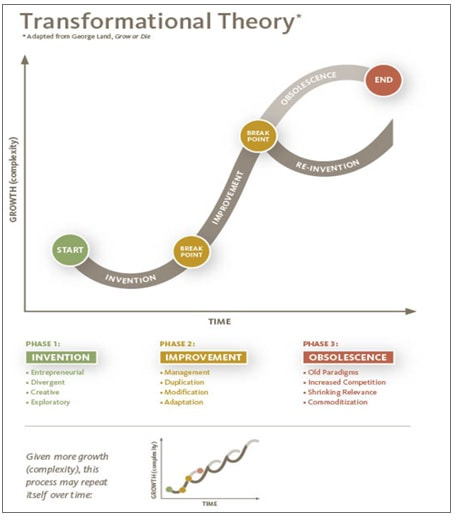 Transformation Theory is a theory of natural processes that integrates principles of creativity, growth, and change. This Theory was developed in 1973 by George Land, Ph.D. It was originally published in George Land’s landmark book, Grow or Die: The Unifying Principle of Transformation. The Transformation Theory describes the universal process of change and growth. Land (2000) asserts that organisms, people, and organizations all progress through the same distinctive phases of the S-Curve as they grow; there is a basic pattern of change throughout all of nature. “His concepts around transformational growth combined with creative strategic thinking were brilliant for the time.” Land (1973) asserts that the imperative of Life is to grow and reproduce; the mandate of nature is to “Grow or Die” According to Land’s Theory of Transformation, every organization goes through the same S-Curve, which begins with a dip as the organization enters the invention phase. Once the initial challenges are resolved, the first break point occurs, and the organization moves into the improvement phase. Because complexity continues to grow outside of the organization a second dip will occur. Re-invention / innovation is necessary at the second break point in order to remain relevant and avoid obsolescence. Source: https://incitechicagoblog.wordpress.com/2011/10/07/125/ Transformation Theory “puts into perspective why and how individuals and organizations grow, change and sometimes renew themselves” (Arizona Technology Council, 2016). Transformation Theory helps managers understand how to manage products and organizations along the s-curve. The theory identifies the three phases of growth within the smoothed curve that have very different rules and characteristics. During the two breakpoints, the behavior of the system must radically shift for it to succeed. Once managers understand these dynamics, they can take full advantage of new opportunities (Land, 2000). Based on George Land’s assertion, Man is not limited to the rigid and fixed genetic patterns of animals who will perform their specific growth tasks., Zylstra (2016) declares that men were destined to innovate, to create a better world. George Land developed a creativity test for NASA to help select innovative engineers and scientists. In 1968, using the same test, George Land conducted a research study to test the creativity of 1,600 children ranging in ages from three-to-five years old. He re-tested the same children at 10 years of age, and again at 15 years of age. The study found that 98% of 5-year olds, 30% of 10-year olds and 12% of 15-year olds scored in the “highly creative” range, respectively. Only 2% of adults scored in the “highly creative” range. “What we have concluded, is that non-creative behavior is learned.” Dr. Land’s studies on the enhancement of creative performance ultimately led to the formulation of Transformation Theory. https://jamesclear.com/creative-thinking Growth is the keystone of Transformation Theory and humans modify their behavior towards growth based on “feedback” received from the environment. Land posits that growth cannot occur independently, but instead requires interaction and interrelationship with the environment. Transformation relates not only to the expression of human behavior, but to those processes that enable man to develop, achieve or loose these expressions. (Land, 1973). If an organization can pinpoint its position on the life cycle curve (S-curve), and it has a sense of the slope of the curve, it has an excellent mechanism for determining where its technology is headed and when interventions should be made. http://ideagenius.com/the-s-curve-pattern-of-innovation-a-full-analysis/ The Transformation Theory recognizes every aspect of human behavior as naturally evolved types of growth. The effectiveness of applying the theory in organizations is contingent upon the robustness of the manager’s forecasts (Modis, 2007 Historically, the orientation of learning and the path to success in organizations was centered around efficiency and best practices; decisions were made at the highest level of the hierarchy with little opportunity for collaboration. Due to the unpredictability and complexity of the 21st Century, the orientation of learning is shifting to creative response and innovation; and information flow in multiple directions and collaborative work are widely embraced. Alphabet / Google the most innovative company in the world today (Forbes, 2019), exemplifies the transformation theory, as it constantly develops new products with overlapping S-Curves, that facilitate its continuous growth in a rapidly changing environment.Though not specifically about the Transformation Theory, the annual Creative Problem Solving Institute (CPSI) at the Creative Education Foundation provides an opportunity for individuals to choose from several experiential programs to learn a proven process for deliberate creativity and innovation. Land, G. (1973). Grow or Die: The Unifying Principle of Transformation. Random House. Land, G. (1973). Grow or Die: The Principle of Transformation. Journal of Creative Behavior. 7:2, 77-132. Land, G. & Jarman B. (1992), Breakpoint and Beyond: Mastering the Future Today. Harpercollins Publishers Land, G. (2000). Creating a Sustainable Competitive Edge. Journal of Innovative Management. Summer, 2000. Land, G. (2011). TEDx Tucson, The Failure of Success. Retrieved from https://www.youtube.com/watch?v=ZfKMq-rYtnc Modis, T. (2007). From My Perspective: Strengths and Weaknesses of the S-Curve. Technological Forecasting & Social Change.74, 866–872 Robinson K. (2007). TED Talk “Do schools kill creativity”. Retrieved from https://www.youtube.com/results?search_query=do+schools+kill+creativity World Business Organization. George Land, Ph. D. (1932 – 2016). Retrieved from https://worldbusiness.org/fellows/george-land-ph-d/ Zylstra, S. (2016). Grow or Die: Remembering Innovator George Land. Retrieved from https://www.bizjournals.com/phoenix/blog/techflash/2016/03/grow-or-die-remembering-innovator-george-land.html
0 Comments
Leave a Reply. |


 RSS Feed
RSS Feed
